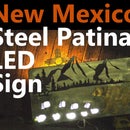Introduction: Metal French Cleat Wall Map - CNC Plasma Cut
My buddy Stu won a project where he needed to build a Steel Wall Map and attach it with French cleats, so he called me up, flew in for the weekend and we got to work!
Step 1: CNC Plasma Cutting
Plasma cutting is the removal of metal with a beam of hot plasma which melts the steel in its path. It's much like a laser, but less accurate and FAR more affordable. Most large projects are suitable to plasma.
We used 10Ga hot rolled steel, which is a bit thicker than 1/8" and has the bluish finish you see here. That's millscale, a compound similar to rust, that is formed hot.
We first cut Eurasia on my 5'x10' CNC Plasma Table, then many Islands and the other Continents. The water in the table serves to cool them metal and catch all the removed metal, keeping the shop cleaner.
Step 2: Surface Prep
Fortunately, my plasma Cutter does a great job of making clean cuts, so the clean up process is really just to wirebrush the whole piece, then use a flap disk to clean up the few spots that need it. We are removing Dross, which is the metal that is left at the edges of a cut, on order to get a nice, clean edge.
Step 3: French Cleat
A French Cleat is a means to attach something to a wall in a way that has some adjustability and can be removed, however in our case we glued the pieces into place after placement. As the continents are steel, the matching cleat needed to be steel too so it could be welded on, but the wall piece was made from a piece of 3/4" plywood. Stu did that in his shop.
We made the steel cleat by welding a piece of 1"x1/8" flat bar along the hypotenuse formed from a triangle with the other sides being a piece of 3/4"x3/4"x1/8" angle iron.
As it is easier to make this weld if the piece is slightly offset, the final form is not a 45-45-90 triangle, see the next step for a clearer explanation.
Step 4: Dealing With Warp
As you weld, you heat steel up, as it cools it warps, generally pulling towards the welds.
We assembled the french cleat with tack welds (short welds) as they are strong enough and add less heat. After tacking up the first side there is a lot of warp, but after the second most of it has warped back. The remainder we can address by manually bending the piece.
Lastly, we ground the tacks away for a smooth face as we wouldn't be able to do so after assembly.
Step 5: Keeping Everything Level
In the Vector File we used to cut out the sheets, we placed some tabs running east to west so we could level our french cleats parallel to a line between the tabs.
After cutting everything out we drew a guide line between the tabs, placed our french cleats, then cut the tabs off with a grinder. We intentionally placed the tabs where they would be easy to remove.
Step 6: LOTS of Welding
When you weld on one side of a piece of metal, it will often show through the other (called a weld scar) so we again used a bunch of tacks to assemble the french cleats onto the backs of the continents. There was still some scarring, but it was minor. Each cleat was placed with care and checked to ensure it was at the needed 45 degree angle.
Step 7: The Islands
Most of the islands of the world were too small to use a french cleat, so we just welded some bolts to the back that will mount into holes in the wall.
Step 8: Shipping and Finish
I created up the continents and shipped them 1000 miles to Chicago for Stu to have powdercoated. powdercoating is like painting except it's a plastic film that is flexible, durable, and resistant to chemicals, making for a much longer lasting finish. As the name implies, the coating is a powder that is sprayed onto the metal then baked to adhere it.
Step 9: Installation
Neither Stu nor I were able to install the project due to requirements of the customer, but their installer followed the directions we gave and did a great job getting everything squared away. Due to the shape of the wall it is mounted on the proportions were a bit squished, but that was planned for and, in my opinion the finished product looks great.













